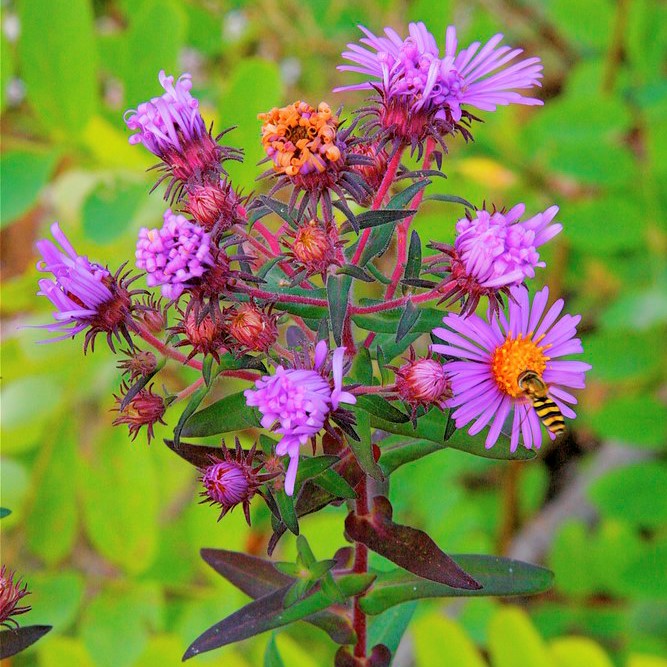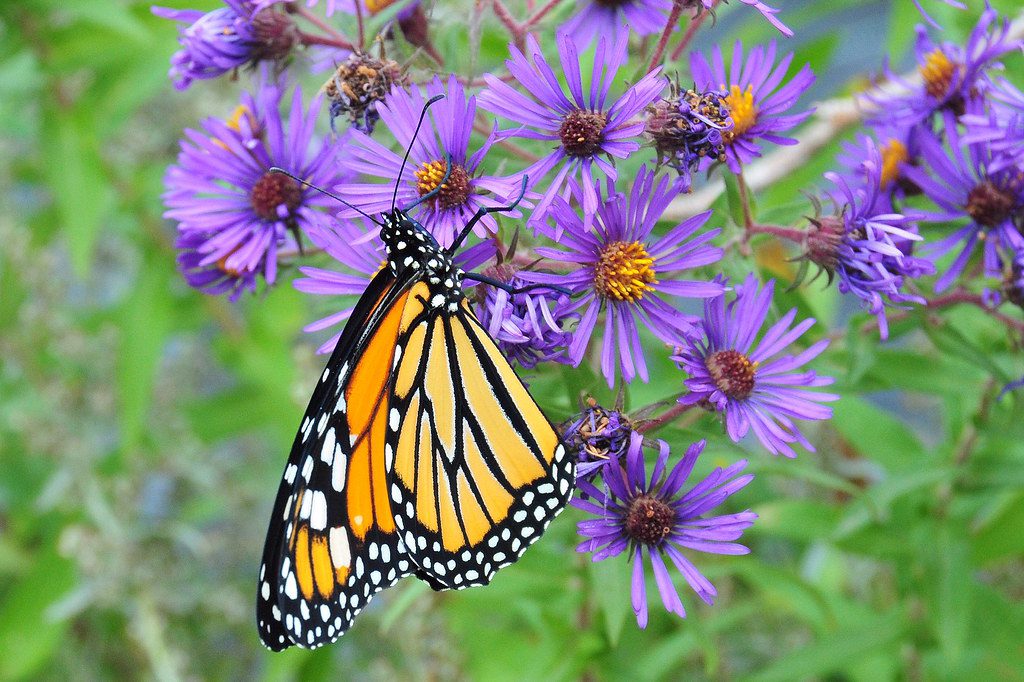Native Plant Profile: New England Aster (Symphyotrichum novae-angliae)
With lilac purple rays and a bright yellow center, New England aster (Symphyotrichum novae-angliae) brings a pop of color to fall gardens. This tall, branching aster can reach heights up to six feet if allowed to grow to its full potential. Each stalk can have over a dozen composite flowers at its tips that bloom from August through October in Maryland. Each composite flower is actually made up of multiple flowers, from yellow disk flowers in the center to purple ray flowers on the edges.
New England aster can be found throughout much of Maryland, though its distribution on the eastern shore is limited. New England aster grows best in moist, well draining soil, in full sun to part shade. It does not grow well in dry soils or full shade. If stressed, particularly by drought conditions, New England aster may drop its lower leaves or the stem will fall over. If planted in the right area, New England aster may self-seed and spread. To control the height of New England aster, you can prune one-third of the plant in early summer. Occasionally, New England asters may need to be staked if blooms get too heavy. To add color to fall gardens, consider planting this species along with late blooming goldenrods.
Multiple cultivars of New England aster can be found on the market, including dwarf varieties like ‘Purple Dome.’ In addition, there are a number of cultivars that have pink flowers instead of the usual purple. PhD research by White (2016) found that the straight native New England aster had significantly more bumblebee and honeybee visits in experimental gardens than the cultivar New England aster ‘Alma Potschke.’ While much of the plant remained the same in the cultivar versus the straight native, the flower color was different, which likely accounted for the decline in visits by pollinators. In a similar trial by Penn State, the straight species New England aster (Symphyotrichum novae-angliae) had three times more pollinator visits than the nativar New England aster ‘Purple Dome.’
Because of its late flowering, New England aster makes a great fall nectar source for a variety of insects, including migrating monarch butterflies. According to Illinois Wildflowers, this plant is primarily visited by long-tongued bees, bee flies, butterflies and skippers and is a host plant for pearl crescent butterflies. A number of moth species, from Isabella tiger moths to smaller geometer moths, often feed on this plant. You may also notice tiny leaf mines from leaf miners, too. As the plant’s seeds mature, some bird species will feed off of it, and New England aster is sometimes consumed by white-tailed deer and rabbits.
References:
Frett and Piat. 2006. Asters for the Mid-Atlantic Region. https://1x848d9mftq5g9wx3epiqa1d-wpengine.netdna-ssl.com/wp-content/uploads/2016/12/Mt_Cuba_Report-Asters_for_Mid-Atlantic.pdf Accessed September 4, 2019.
Hilty, J. 2019. Illinois Wildflowers website. https://www.illinoiswildflowers.info/ Accessed September 4, 2019.
Holcomb, E. J. and C. Schmotzer. 2015. Bees, Bugs, and Blooms Penn State Extension. https://ento.psu.edu/pollinators/resources-and-outreach/bees-bugs-blooms-2013-a-pollinator-trial Accessed October 2, 2019.
White, A. 2016. From nursery to nature: evaluating native herbaceous flowering plants versus native cultivars for pollinator habitat restoration. Unpublished doctoral thesis, University of Vermont.
Happy Fall!
Fall is my favorite time of year. I love the sights and smells as the summer fades, and it is a great time to be out in the garden. Currently, many animals are in the midst of migration, and we are having some record breaking dragonfly migration swarms this year! As fall unfolds, here are a few things to consider this time of year:
In addition, last year’s rainy summer, coupled with this year’s drought and other factors, have taken a toll on oaks in our region. The University of Maryland Extension has put together an informative and concise article on Why Oak Trees are Declining. If you are in need of trees and shrubs for conservation or lumber, check out the Maryland State Tree Nursery which is accepting orders for Spring 2020.
In this issue, you can learn about a lovely native wildflower, the New England aster, as well as a native group of bees called sweat bees that help to pollinate New England aster and its relatives. In addition, with advances in plant research, we are learning more about how cultivars affect our landscapes. Finally, learn about an up and coming invasive insect in Maryland, the spotted lanternfly, and how to report if you see one in the state.
Happy Habitats,
Kerry Wixted
Click here to have HabiChat—the quarterly backyard wildlife habitat newsletter from the Wild Acres program—delivered right to your inbox!
In this Issue
Native Animal Profile: Sweat Bees (aka Halictid Bees)
Search and Destroy: the Spotted Lanterfly
The Cultivar Question




 1-888-373-7888
1-888-373-7888 233733
233733